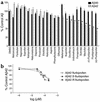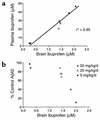NSAIDs and enantiomers of flurbiprofen target gamma-secretase and lower Abeta 42 in vivo - PubMed (original) (raw)
NSAIDs and enantiomers of flurbiprofen target gamma-secretase and lower Abeta 42 in vivo
Jason L Eriksen et al. J Clin Invest. 2003 Aug.
Abstract
Epidemiologic studies demonstrate that long-term use of NSAIDs is associated with a reduced risk for the development of Alzheimer disease (AD). In this study, 20 commonly used NSAIDs, dapsone, and enantiomers of flurbiprofen were analyzed for their ability to lower the level of the 42-amino-acid form of amyloid beta protein (Abeta42) in a human H4 cell line. Thirteen of the NSAIDs and the enantiomers of flurbiprofen were then tested in acute dosing studies in amyloid beta protein precursor (APP) transgenic mice, and plasma and brain levels of Abeta and the drug were evaluated. These studies show that (a). eight FDA-approved NSAIDs lower Abeta42 in vivo, (b). the ability of an NSAID to lower Abeta42 levels in cell culture is highly predicative of its in vivo activity, (c). in vivo Abeta42 lowering in mice occurs at drug levels achievable in humans, and (d). there is a significant correlation between Abeta42 lowering and levels of ibuprofen. Importantly, flurbiprofen and its enantiomers selectively lower Abeta42 levels in broken cell gamma-secretase assays, indicating that these compounds directly target the gamma-secretase complex that generates Abeta from APP. Of the compounds tested, meclofenamic acid, racemic flurbiprofen, and the purified R and S enantiomers of flurbiprofen lowered Abeta42 levels to the greatest extent. Because R-flurbiprofen reduces Abeta42 levels by targeting gamma-secretase and has reduced side effects related to inhibition of cyclooxygenase (COX), it is an excellent candidate for clinical testing as an Abeta42 lowering agent.
Figures
Figure 1
Effects of NSAIDs on Aβ42 production in human neuroglioma line. (a) H4 cells were treated for 6 hours with 100 μM of the compounds dissolved in DMSO vehicle, and Aβ levels in the media were determined by Aβ ELISA. Results are the average of two experiments, each performed in duplicate. Compounds are ordered by effect on Aβ42. Experimental values are compared to six control samples. *P < 0.05 by ANOVA with Dunnet’s post hoc correction. Aβ40 production was not significantly affected by any of the compounds when tested at 100 μM. (b) Dose response of racemic, _R_- and _S_-flurbiprofen. H4 cells were treated with various concentrations of racemic flurbiprofen or its purified enantiomers. All three forms of flurbiprofen selectively lower Aβ42 to approximately identical extents. At concentrations above 300 μM, moderate reductions in Aβ40 were seen, but LDH assays indicated cells treated at these doses exhibited signs of toxicity. In these experiments, control values for secreted Aβ40 and Aβ42 were greater than 500 pM and 40 pM, respectively.
Figure 2
IP/MS analysis of Aβ in the media of racemic, _R_- and _S_-flurbiprofen–treated cells. Plots shown are representative of two experiments, each performed in duplicate. CHO cells overexpressing APP751 and PS1ML were pretreated overnight with ethanol (a), 250 μM racemic flurbiprofen (b), 250 μM _S_-flurbiprofen (c), or 250 μM _R_-flurbiprofen (d). Conditioned medium was collected and analyzed after an additional 24 hours of treatment with the same concentration of the drug. Aβ peptides identified by their masses are indicated above the peaks. All forms of flurbiprofen reduce the Aβ42 peak and increase the levels of shorter Aβ derivatives to approximately the same extent. This effect is best seen by comparing the peak heights of the various peptides to the peak height of Aβ1–40, which is largely unchanged.
Figure 3
Flurbiprofen and _R_-flurbiprofen selectively lower Aβ42 in broken cell γ-secretase assays. Dose-response studies of Aβ40 and Aβ42 production in a broken cell assay shows that Aβ42 production is selectively inhibited by flurbiprofen and its enantiomers in vitro. Error bars indicate the SEM. Similar results are seen with purified _S_-flurbiprofen (data not shown). Data are averaged from two independent experiments with duplicate samples at each dose. Absolute control values are 1143 ± 51 pM for Aβ40 production and 91 ± 9 pM for Aβ42 production.
Figure 4
Effects of NSAIDs on Aβ42 in Tg2576 brain. The graphs illustrate the percent of control values seen in each experimental group ± SEM, and the number in parentheses indicates mice per group. Treated groups were compared with controls using ANOVA with Dunnet’s post hoc correction. (a) Survey of FDA-approved NSAIDs. Brain levels of Aβ were determined after 3 days of oral dosing and compared with controls treated with vehicle alone. All animals were treated with 50 mg/kg per day except for indomethacin, which was dosed at 10 mg/kg per day (#P = 0.051, *P < 0.03, **P < 0.01). A statistically significant 17% reduction in Aβ42 levels is seen in the diclofenac treatment group (n = 8 animals), whereas a nonsignificant trend is noted in the piroxicam treatment group (n = 4), despite the fact that the average decrease in Aβ42 levels is larger (19%). Control values for the untreated Tg2576 mice are 18.5 ± 0.7 pM/gm for Aβ40 and 7.7 ± 0.3 pM/gm for Aβ42. (b) Dose-response studies with _R_- and _S_-flurbiprofen. Brain levels of Aβ were determined after 3 days of oral dosing and compared with controls treated with vehicle alone. All of these treatments significantly lowered Aβ42 levels. Treatment with 25 and 50 mg/kg per day of _S_-flurbiprofen also lowered Aβ40 levels, an effect possibly attributable to toxicity; no effect was seen on Aβ40 with _R_-flurbiprofen treatment (*P < 0.01, **P < 0.01). (c) Comparison between Aβ42 levels in cell culture and in transgenic mice. Mean inhibition of Aβ42 production is shown in the H4 cell line (in vitro, gray bars) and in TG2576 mice (in vivo, black bars).
Figure 5
In vivo relationship between ibuprofen levels and brain Aβ42 levels. Tg2576 mice were dosed with 5, 25, or 50 mg/kg per day, and plasma and brain levels of ibuprofen were determined. (a) Ibuprofen levels in brain and plasma are highly correlated. Plasma ibuprofen concentrations ranged from 3 to 47 μM and brain levels from 0.3 to 2.1 μM. There was a strong correlation between brain and plasma levels (_r_2 = 0.95); as expected, there was a wide range in levels based on the dosage of ibuprofen. Approximately 6% of detectable plasma ibuprofen is found in the CNS. (b) A high degree of correlation (_r_2 = 0.96, three-order polynomial) is seen between ibuprofen concentrations in the CNS and Aβ42 production. Aβ42 levels were significantly decreased by either 25 or 50 mg/kg per day of ibuprofen; at 5 mg/kg per day of ibuprofen there was a small, nonsignificant decrease in Aβ42 levels.
Comment in
- Amyloid beta and Alzheimer disease therapeutics: the devil may be in the details.
Cirrito JR, Holtzman DM. Cirrito JR, et al. J Clin Invest. 2003 Aug;112(3):321-3. doi: 10.1172/JCI19420. J Clin Invest. 2003. PMID: 12897198 Free PMC article.
Similar articles
- A subset of NSAIDs lower amyloidogenic Abeta42 independently of cyclooxygenase activity.
Weggen S, Eriksen JL, Das P, Sagi SA, Wang R, Pietrzik CU, Findlay KA, Smith TE, Murphy MP, Bulter T, Kang DE, Marquez-Sterling N, Golde TE, Koo EH. Weggen S, et al. Nature. 2001 Nov 8;414(6860):212-6. doi: 10.1038/35102591. Nature. 2001. PMID: 11700559 - In vitro and in vivo profiling of CHF5022 and CHF5074 Two beta-amyloid1-42 lowering agents.
Imbimbo BP, Del Giudice E, Cenacchi V, Volta R, Villetti G, Facchinetti F, Riccardi B, Puccini P, Moretto N, Grassi F, Ottonello S, Leon A. Imbimbo BP, et al. Pharmacol Res. 2007 Apr;55(4):318-28. doi: 10.1016/j.phrs.2006.12.010. Epub 2007 Jan 16. Pharmacol Res. 2007. PMID: 17292621 - 1-(3',4'-Dichloro-2-fluoro[1,1'-biphenyl]-4-yl)-cyclopropanecarboxylic acid (CHF5074), a novel gamma-secretase modulator, reduces brain beta-amyloid pathology in a transgenic mouse model of Alzheimer's disease without causing peripheral toxicity.
Imbimbo BP, Del Giudice E, Colavito D, D'Arrigo A, Dalle Carbonare M, Villetti G, Facchinetti F, Volta R, Pietrini V, Baroc MF, Serneels L, De Strooper B, Leon A. Imbimbo BP, et al. J Pharmacol Exp Ther. 2007 Dec;323(3):822-30. doi: 10.1124/jpet.107.129007. Epub 2007 Sep 25. J Pharmacol Exp Ther. 2007. PMID: 17895400 - Gamma-secretase modulation with Abeta42-lowering nonsteroidal anti-inflammatory drugs and derived compounds.
Czirr E, Weggen S. Czirr E, et al. Neurodegener Dis. 2006;3(4-5):298-304. doi: 10.1159/000095270. Neurodegener Dis. 2006. PMID: 17047371 Review. - The potential role of non-steroidal anti-inflammatory drugs in treating Alzheimer's disease.
Imbimbo BP. Imbimbo BP. Expert Opin Investig Drugs. 2004 Nov;13(11):1469-81. doi: 10.1517/13543784.13.11.1469. Expert Opin Investig Drugs. 2004. PMID: 15500394 Review.
Cited by
- Consequences of inhibiting amyloid precursor protein processing enzymes on synaptic function and plasticity.
Wang H, Megill A, He K, Kirkwood A, Lee HK. Wang H, et al. Neural Plast. 2012;2012:272374. doi: 10.1155/2012/272374. Epub 2012 Jun 26. Neural Plast. 2012. PMID: 22792491 Free PMC article. Review. - Integrated Pathways of COX-2 and mTOR: Roles in Cell Sensing and Alzheimer's Disease.
Tyagi A, Kamal MA, Poddar NK. Tyagi A, et al. Front Neurosci. 2020 Jul 9;14:693. doi: 10.3389/fnins.2020.00693. eCollection 2020. Front Neurosci. 2020. PMID: 32742252 Free PMC article. Review. - Molecular Mechanism for Various Pharmacological Activities of NSAIDS.
Mizushima T. Mizushima T. Pharmaceuticals (Basel). 2010 May 25;3(5):1614-1636. doi: 10.3390/ph3051614. Pharmaceuticals (Basel). 2010. PMID: 27713320 Free PMC article. Review. - The microglial NADPH oxidase complex as a source of oxidative stress in Alzheimer's disease.
Wilkinson BL, Landreth GE. Wilkinson BL, et al. J Neuroinflammation. 2006 Nov 9;3:30. doi: 10.1186/1742-2094-3-30. J Neuroinflammation. 2006. PMID: 17094809 Free PMC article. - An alternative interpretation of the amyloid Abeta hypothesis with regard to the pathogenesis of Alzheimer's disease.
Marchesi VT. Marchesi VT. Proc Natl Acad Sci U S A. 2005 Jun 28;102(26):9093-8. doi: 10.1073/pnas.0503181102. Epub 2005 Jun 20. Proc Natl Acad Sci U S A. 2005. PMID: 15967987 Free PMC article.
References
- Selkoe DJ. Alzheimer’s disease: genes, proteins, and therapy. Physiol. Rev. 2001;81:741–766. - PubMed
- Hardy JA, Higgins GA. Alzheimer’s disease: the amyloid cascade hypothesis. Science. 1992;256:184–185. - PubMed
- Golde TE, Eckman CB, Younkin SG. Biochemical detection of Aβ isoforms: implications for pathogenesis, diagnosis, and treatment of Alzheimer’s disease. . Biochim. Biophys. Acta. 2000; 1502:172–187. - PubMed
- Younkin SG. The role of A beta 42 in Alzheimer’s disease. J. Physiol. (Paris). 1998;92:289–292. - PubMed
- Scheuner D, et al. Secreted amyloid beta-protein similar to that in the senile plaques of Alzheimer’s disease is increased in vivo by the presenilin 1 and 2 and APP mutations linked to familial Alzheimer’s disease. Nat. Med. 1996;2:864–870. - PubMed
Publication types
MeSH terms
Substances
LinkOut - more resources
Full Text Sources
Other Literature Sources
Medical




